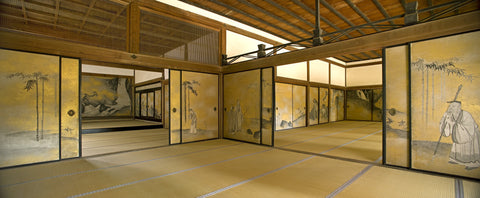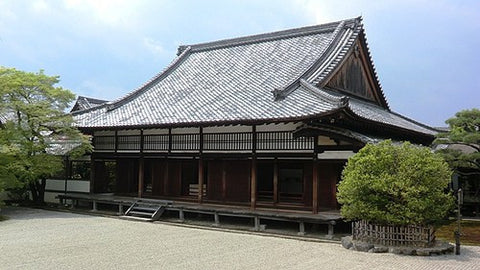When the practice of drinking Matcha green tea reached Japan towards the end of the 12th century. It became quite common among the upper class to arrange social gatherings to drink Matcha. Over time, these tea drinking gatherings began to take place in the Shoin, to combine the the appreciation of the Matcha with the Chinese paintings and crafts placed in this serene room.

The shōin is a desk alcove that projects onto a verandah. Above it, lies a window made of latticework wood which is typically covered with a translucent, hard white paper. Fitted with shelves, the shōin was common and quite popular feature of a Japanese priest’s house, with displays of fine artworks in the alcove (tokonama). Capacious tokonoma on one wall and gold-leafed doors on the other, are typical features of the shōin.

These ample rooms are found in the Momoyama era in temples as well as the dwellings of the elite and even the extravagant fortresses built by newly risen war lords.
The shōin lends its name to the architectural style called shōin-zukuri. Housings built on the shōin-zukuri style, have a room dedicated to receiving guests known as zashiki. This style of architecture is thought to have its roots in the Chinese culture which was brought to Japan by Zen Buddhist monks.
By late Kamakura era (1192–1333), the shōin became common in the houses of priests. And it wasn’t long after that when every aristocratic housing had a shōin of its own, adding an erudite touch to the main guest room.
Literally meaning “study”, the shōin was originally built as a study room in Zen monasteries, full of bookshelves. However, artworks and utensils started appearing along with books in these rooms in the Muromachi period (1392–1573). In fact, the shōin was held in such high regard that the architecture of the Muromachi period was deeply influenced by the appearance and use of this room.
One of the most prominent architectural developments to emerge from this influence is the practice of lining the floors of the room with Tatami (straw mats). Also, the architecture of the shōin influenced distinguished features like the chigaidana, which are built in shelves into the tokonoma. These shelves were used for displaying smaller artworks.
The rise of the the shōin architecture also gave birth to the rise of fusuma, sliding doors that are characteristic of Japanese rooms.
Since mid-16th century, aristocrats in Japan have used these sophisticated rooms as reception halls for guests as well as messengers.

As is common in Japanese housings, the shōin features exposed beams and posts.
In the coffered ceilings and latticework, one can find the amazing precision of their joinery techniques.
To Western eyes, the shōin can seem unnecessarily spacious. But if you look closely, you can actually find many aspects worthy of admiration, such as the gilded bronze door pulls and evocative paintings on the doors, the finely woven tatami mats and the refined proportions of the entire room.
The truth is, the shōin can be as evocative as a museum. You can spend hours in this room and still not be done admiring everything.
Comments will be approved before showing up.